A Study on Sustainable Management and Marketing at CSL Company
VerifiedAdded on 2020/05/28
|12
|3489
|25
Report
AI Summary
This report examines CSL's sustainable management and marketing practices. It begins with an introduction to sustainability and its importance in business, followed by a marketing background of CSL, a global biotechnology company. The report analyzes CSL's customer relationships, brand positioning, and supplier management. It also explores product sustainability, pricing, and distribution strategies, emphasizing CSL's commitment to environmental responsibility and innovation. The report concludes with recommendations for CSL's sustainable marketing efforts and highlights the company's focus on innovation, integrity, and collaboration. The report also touches upon the competitive landscape, including key competitors like GSK, AstraZeneca, and Pfizer, and their respective marketing approaches. The report showcases CSL's strategic initiatives such as the EHS plan and its commitment to innovation and research and development to maintain its market position. This report is a valuable resource for understanding the integration of sustainability into the biotechnology sector.
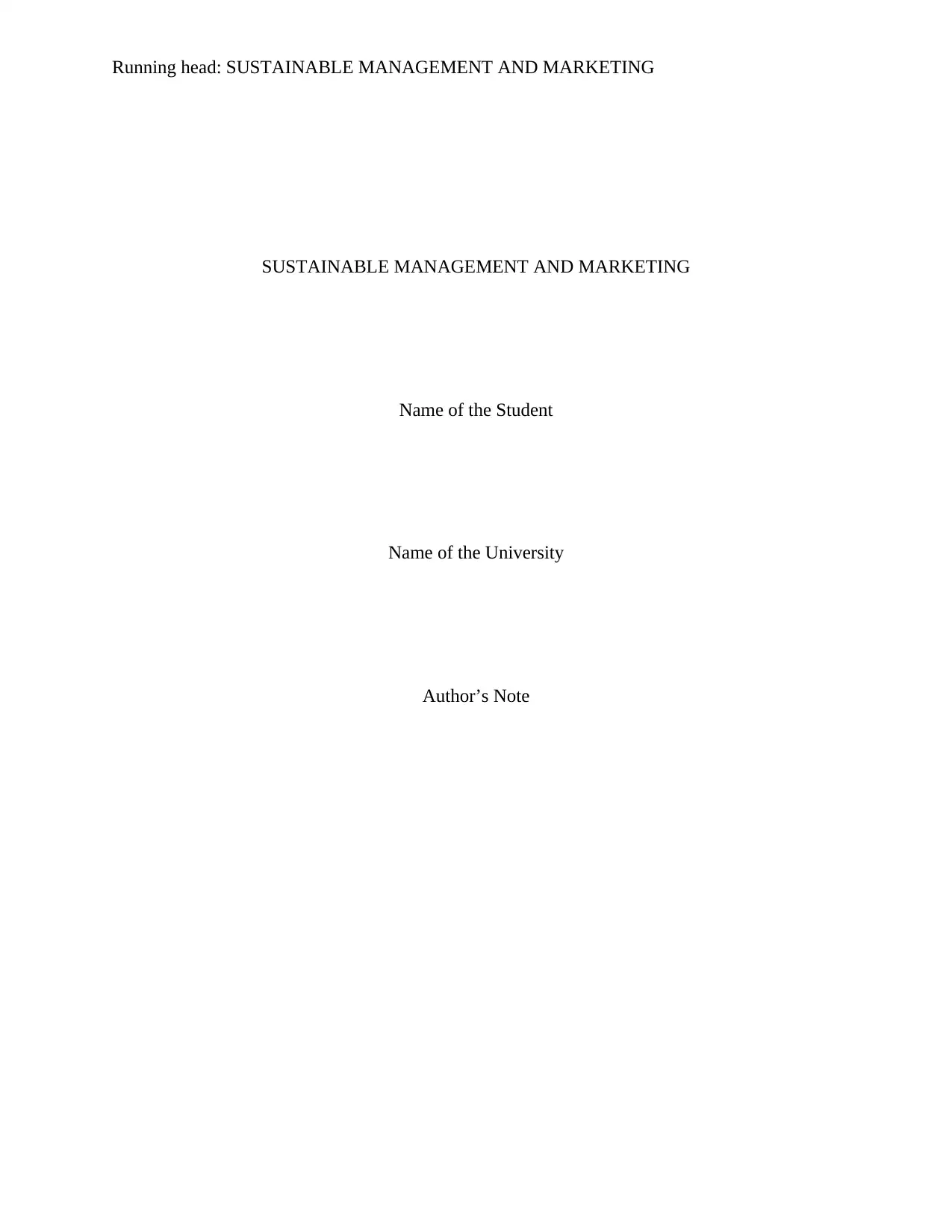
Running head: SUSTAINABLE MANAGEMENT AND MARKETING
SUSTAINABLE MANAGEMENT AND MARKETING
Name of the Student
Name of the University
Author’s Note
SUSTAINABLE MANAGEMENT AND MARKETING
Name of the Student
Name of the University
Author’s Note
Paraphrase This Document
Need a fresh take? Get an instant paraphrase of this document with our AI Paraphraser
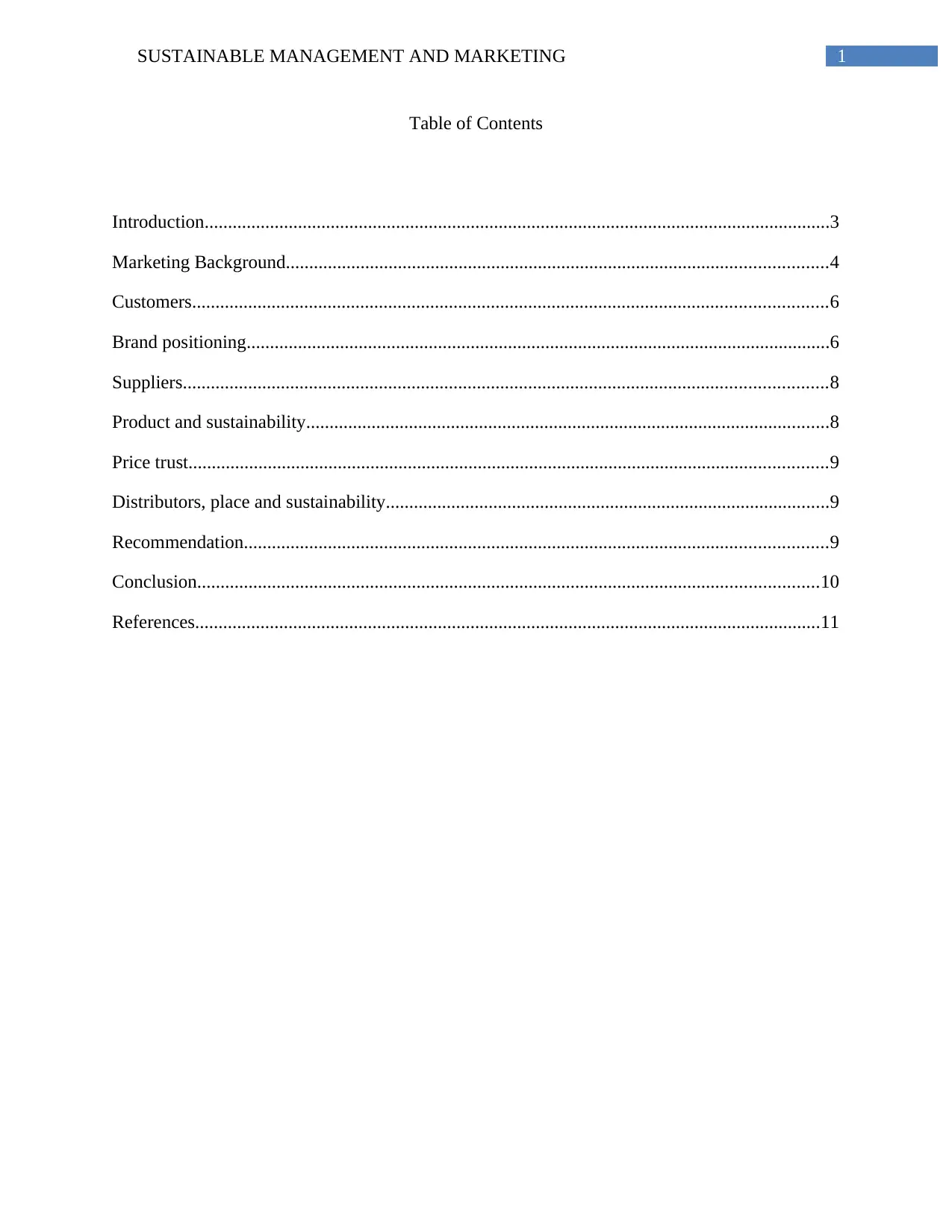
1SUSTAINABLE MANAGEMENT AND MARKETING
Table of Contents
Introduction......................................................................................................................................3
Marketing Background....................................................................................................................4
Customers........................................................................................................................................6
Brand positioning.............................................................................................................................6
Suppliers..........................................................................................................................................8
Product and sustainability................................................................................................................8
Price trust.........................................................................................................................................9
Distributors, place and sustainability...............................................................................................9
Recommendation.............................................................................................................................9
Conclusion.....................................................................................................................................10
References......................................................................................................................................11
Table of Contents
Introduction......................................................................................................................................3
Marketing Background....................................................................................................................4
Customers........................................................................................................................................6
Brand positioning.............................................................................................................................6
Suppliers..........................................................................................................................................8
Product and sustainability................................................................................................................8
Price trust.........................................................................................................................................9
Distributors, place and sustainability...............................................................................................9
Recommendation.............................................................................................................................9
Conclusion.....................................................................................................................................10
References......................................................................................................................................11
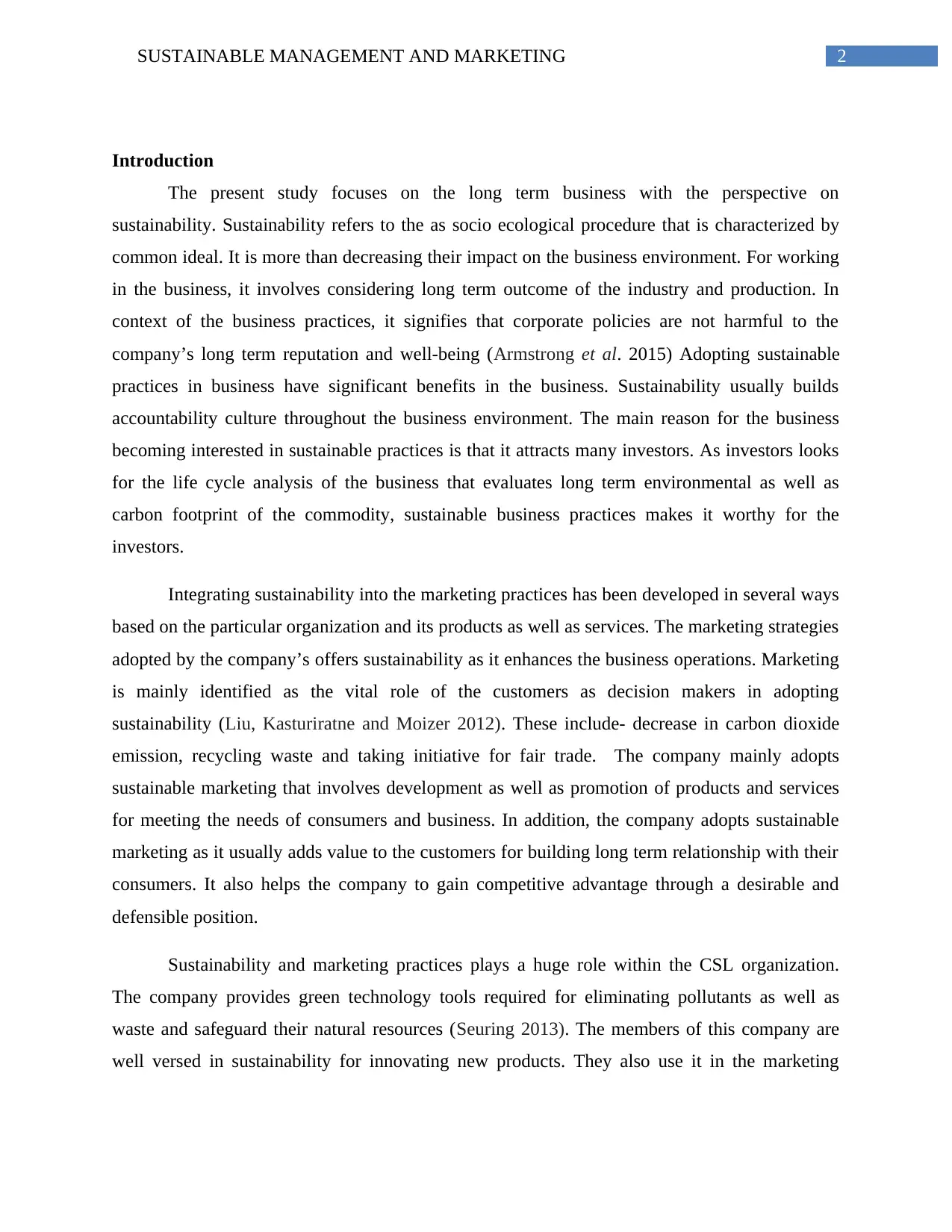
2SUSTAINABLE MANAGEMENT AND MARKETING
Introduction
The present study focuses on the long term business with the perspective on
sustainability. Sustainability refers to the as socio ecological procedure that is characterized by
common ideal. It is more than decreasing their impact on the business environment. For working
in the business, it involves considering long term outcome of the industry and production. In
context of the business practices, it signifies that corporate policies are not harmful to the
company’s long term reputation and well-being (Armstrong et al. 2015) Adopting sustainable
practices in business have significant benefits in the business. Sustainability usually builds
accountability culture throughout the business environment. The main reason for the business
becoming interested in sustainable practices is that it attracts many investors. As investors looks
for the life cycle analysis of the business that evaluates long term environmental as well as
carbon footprint of the commodity, sustainable business practices makes it worthy for the
investors.
Integrating sustainability into the marketing practices has been developed in several ways
based on the particular organization and its products as well as services. The marketing strategies
adopted by the company’s offers sustainability as it enhances the business operations. Marketing
is mainly identified as the vital role of the customers as decision makers in adopting
sustainability (Liu, Kasturiratne and Moizer 2012). These include- decrease in carbon dioxide
emission, recycling waste and taking initiative for fair trade. The company mainly adopts
sustainable marketing that involves development as well as promotion of products and services
for meeting the needs of consumers and business. In addition, the company adopts sustainable
marketing as it usually adds value to the customers for building long term relationship with their
consumers. It also helps the company to gain competitive advantage through a desirable and
defensible position.
Sustainability and marketing practices plays a huge role within the CSL organization.
The company provides green technology tools required for eliminating pollutants as well as
waste and safeguard their natural resources (Seuring 2013). The members of this company are
well versed in sustainability for innovating new products. They also use it in the marketing
Introduction
The present study focuses on the long term business with the perspective on
sustainability. Sustainability refers to the as socio ecological procedure that is characterized by
common ideal. It is more than decreasing their impact on the business environment. For working
in the business, it involves considering long term outcome of the industry and production. In
context of the business practices, it signifies that corporate policies are not harmful to the
company’s long term reputation and well-being (Armstrong et al. 2015) Adopting sustainable
practices in business have significant benefits in the business. Sustainability usually builds
accountability culture throughout the business environment. The main reason for the business
becoming interested in sustainable practices is that it attracts many investors. As investors looks
for the life cycle analysis of the business that evaluates long term environmental as well as
carbon footprint of the commodity, sustainable business practices makes it worthy for the
investors.
Integrating sustainability into the marketing practices has been developed in several ways
based on the particular organization and its products as well as services. The marketing strategies
adopted by the company’s offers sustainability as it enhances the business operations. Marketing
is mainly identified as the vital role of the customers as decision makers in adopting
sustainability (Liu, Kasturiratne and Moizer 2012). These include- decrease in carbon dioxide
emission, recycling waste and taking initiative for fair trade. The company mainly adopts
sustainable marketing that involves development as well as promotion of products and services
for meeting the needs of consumers and business. In addition, the company adopts sustainable
marketing as it usually adds value to the customers for building long term relationship with their
consumers. It also helps the company to gain competitive advantage through a desirable and
defensible position.
Sustainability and marketing practices plays a huge role within the CSL organization.
The company provides green technology tools required for eliminating pollutants as well as
waste and safeguard their natural resources (Seuring 2013). The members of this company are
well versed in sustainability for innovating new products. They also use it in the marketing
⊘ This is a preview!⊘
Do you want full access?
Subscribe today to unlock all pages.

Trusted by 1+ million students worldwide
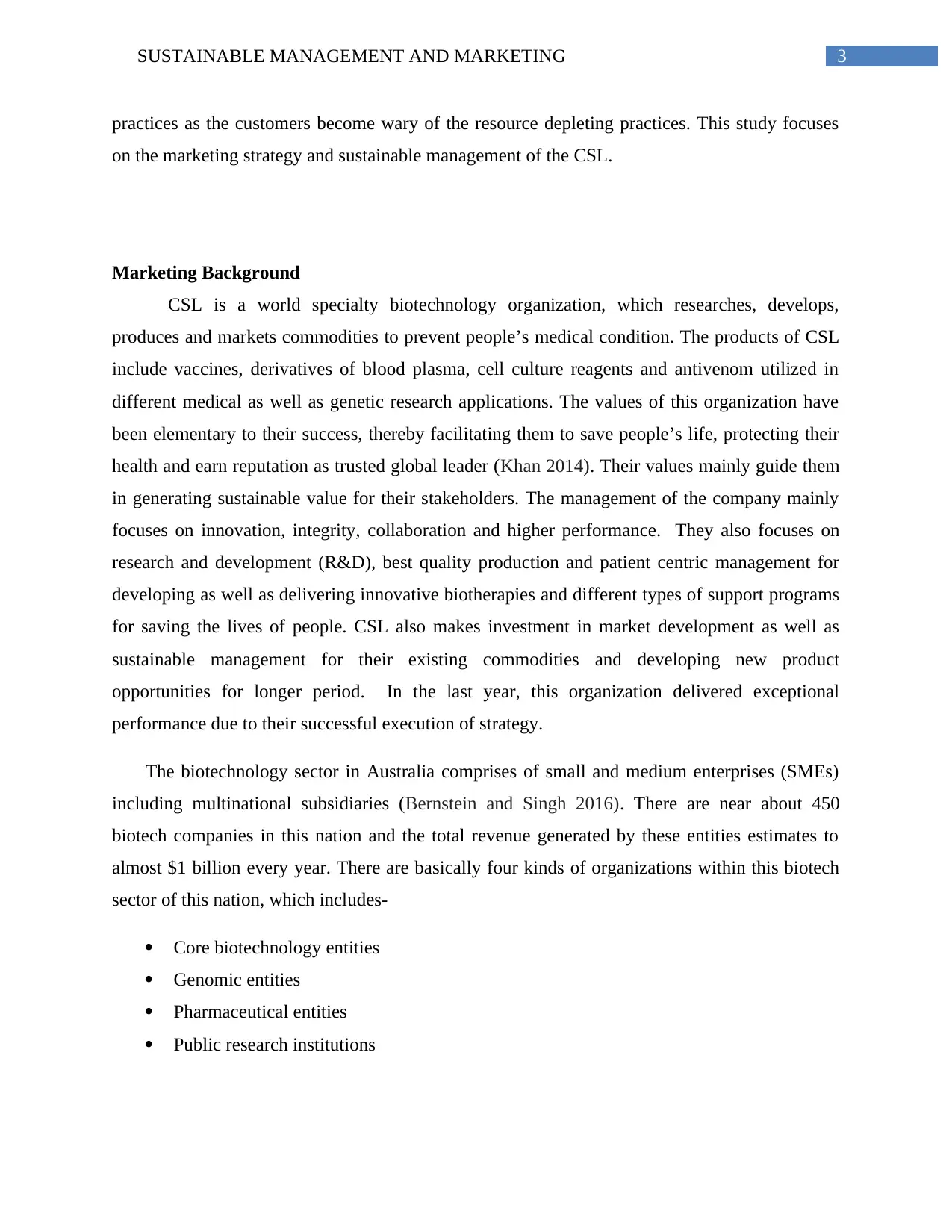
3SUSTAINABLE MANAGEMENT AND MARKETING
practices as the customers become wary of the resource depleting practices. This study focuses
on the marketing strategy and sustainable management of the CSL.
Marketing Background
CSL is a world specialty biotechnology organization, which researches, develops,
produces and markets commodities to prevent people’s medical condition. The products of CSL
include vaccines, derivatives of blood plasma, cell culture reagents and antivenom utilized in
different medical as well as genetic research applications. The values of this organization have
been elementary to their success, thereby facilitating them to save people’s life, protecting their
health and earn reputation as trusted global leader (Khan 2014). Their values mainly guide them
in generating sustainable value for their stakeholders. The management of the company mainly
focuses on innovation, integrity, collaboration and higher performance. They also focuses on
research and development (R&D), best quality production and patient centric management for
developing as well as delivering innovative biotherapies and different types of support programs
for saving the lives of people. CSL also makes investment in market development as well as
sustainable management for their existing commodities and developing new product
opportunities for longer period. In the last year, this organization delivered exceptional
performance due to their successful execution of strategy.
The biotechnology sector in Australia comprises of small and medium enterprises (SMEs)
including multinational subsidiaries (Bernstein and Singh 2016). There are near about 450
biotech companies in this nation and the total revenue generated by these entities estimates to
almost $1 billion every year. There are basically four kinds of organizations within this biotech
sector of this nation, which includes-
Core biotechnology entities
Genomic entities
Pharmaceutical entities
Public research institutions
practices as the customers become wary of the resource depleting practices. This study focuses
on the marketing strategy and sustainable management of the CSL.
Marketing Background
CSL is a world specialty biotechnology organization, which researches, develops,
produces and markets commodities to prevent people’s medical condition. The products of CSL
include vaccines, derivatives of blood plasma, cell culture reagents and antivenom utilized in
different medical as well as genetic research applications. The values of this organization have
been elementary to their success, thereby facilitating them to save people’s life, protecting their
health and earn reputation as trusted global leader (Khan 2014). Their values mainly guide them
in generating sustainable value for their stakeholders. The management of the company mainly
focuses on innovation, integrity, collaboration and higher performance. They also focuses on
research and development (R&D), best quality production and patient centric management for
developing as well as delivering innovative biotherapies and different types of support programs
for saving the lives of people. CSL also makes investment in market development as well as
sustainable management for their existing commodities and developing new product
opportunities for longer period. In the last year, this organization delivered exceptional
performance due to their successful execution of strategy.
The biotechnology sector in Australia comprises of small and medium enterprises (SMEs)
including multinational subsidiaries (Bernstein and Singh 2016). There are near about 450
biotech companies in this nation and the total revenue generated by these entities estimates to
almost $1 billion every year. There are basically four kinds of organizations within this biotech
sector of this nation, which includes-
Core biotechnology entities
Genomic entities
Pharmaceutical entities
Public research institutions
Paraphrase This Document
Need a fresh take? Get an instant paraphrase of this document with our AI Paraphraser
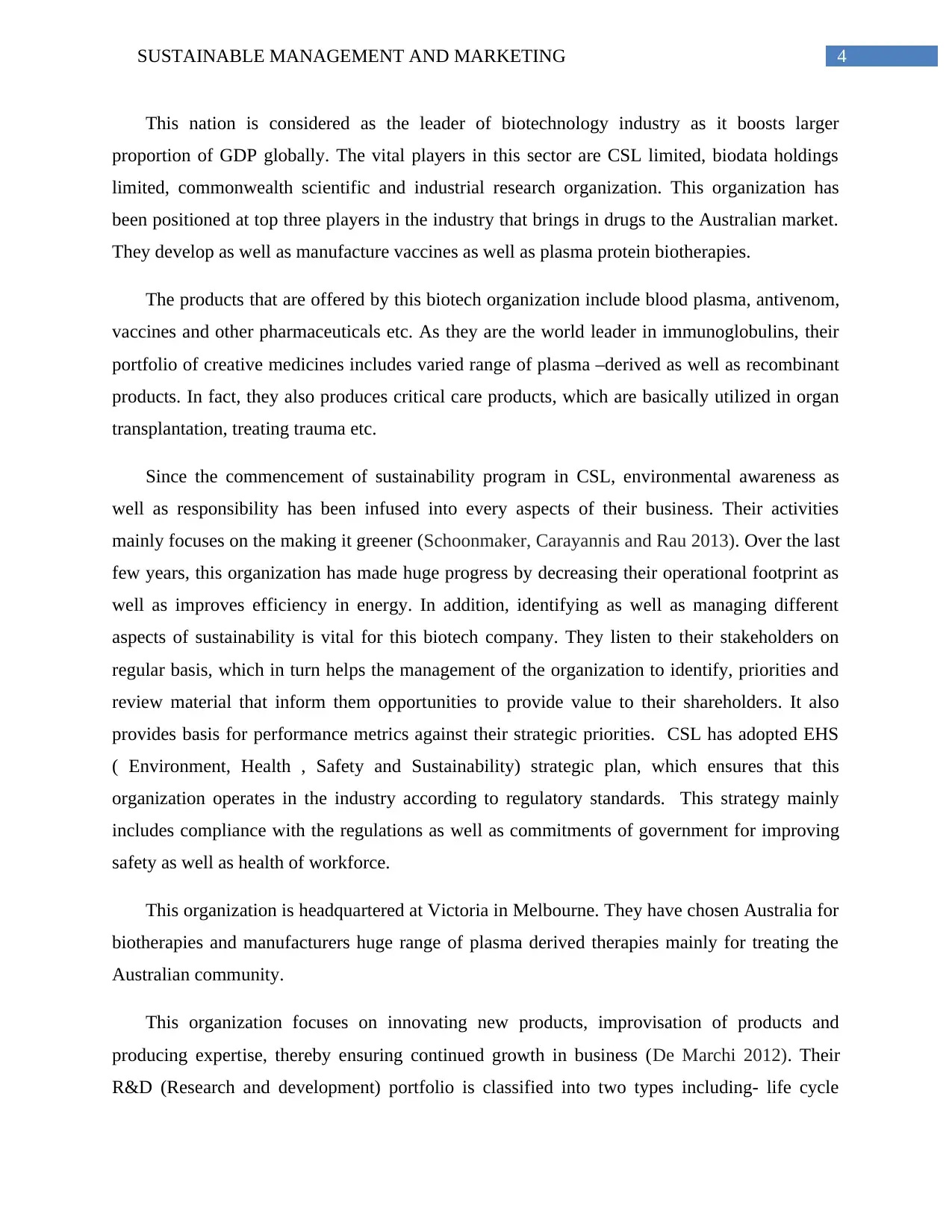
4SUSTAINABLE MANAGEMENT AND MARKETING
This nation is considered as the leader of biotechnology industry as it boosts larger
proportion of GDP globally. The vital players in this sector are CSL limited, biodata holdings
limited, commonwealth scientific and industrial research organization. This organization has
been positioned at top three players in the industry that brings in drugs to the Australian market.
They develop as well as manufacture vaccines as well as plasma protein biotherapies.
The products that are offered by this biotech organization include blood plasma, antivenom,
vaccines and other pharmaceuticals etc. As they are the world leader in immunoglobulins, their
portfolio of creative medicines includes varied range of plasma –derived as well as recombinant
products. In fact, they also produces critical care products, which are basically utilized in organ
transplantation, treating trauma etc.
Since the commencement of sustainability program in CSL, environmental awareness as
well as responsibility has been infused into every aspects of their business. Their activities
mainly focuses on the making it greener (Schoonmaker, Carayannis and Rau 2013). Over the last
few years, this organization has made huge progress by decreasing their operational footprint as
well as improves efficiency in energy. In addition, identifying as well as managing different
aspects of sustainability is vital for this biotech company. They listen to their stakeholders on
regular basis, which in turn helps the management of the organization to identify, priorities and
review material that inform them opportunities to provide value to their shareholders. It also
provides basis for performance metrics against their strategic priorities. CSL has adopted EHS
( Environment, Health , Safety and Sustainability) strategic plan, which ensures that this
organization operates in the industry according to regulatory standards. This strategy mainly
includes compliance with the regulations as well as commitments of government for improving
safety as well as health of workforce.
This organization is headquartered at Victoria in Melbourne. They have chosen Australia for
biotherapies and manufacturers huge range of plasma derived therapies mainly for treating the
Australian community.
This organization focuses on innovating new products, improvisation of products and
producing expertise, thereby ensuring continued growth in business (De Marchi 2012). Their
R&D (Research and development) portfolio is classified into two types including- life cycle
This nation is considered as the leader of biotechnology industry as it boosts larger
proportion of GDP globally. The vital players in this sector are CSL limited, biodata holdings
limited, commonwealth scientific and industrial research organization. This organization has
been positioned at top three players in the industry that brings in drugs to the Australian market.
They develop as well as manufacture vaccines as well as plasma protein biotherapies.
The products that are offered by this biotech organization include blood plasma, antivenom,
vaccines and other pharmaceuticals etc. As they are the world leader in immunoglobulins, their
portfolio of creative medicines includes varied range of plasma –derived as well as recombinant
products. In fact, they also produces critical care products, which are basically utilized in organ
transplantation, treating trauma etc.
Since the commencement of sustainability program in CSL, environmental awareness as
well as responsibility has been infused into every aspects of their business. Their activities
mainly focuses on the making it greener (Schoonmaker, Carayannis and Rau 2013). Over the last
few years, this organization has made huge progress by decreasing their operational footprint as
well as improves efficiency in energy. In addition, identifying as well as managing different
aspects of sustainability is vital for this biotech company. They listen to their stakeholders on
regular basis, which in turn helps the management of the organization to identify, priorities and
review material that inform them opportunities to provide value to their shareholders. It also
provides basis for performance metrics against their strategic priorities. CSL has adopted EHS
( Environment, Health , Safety and Sustainability) strategic plan, which ensures that this
organization operates in the industry according to regulatory standards. This strategy mainly
includes compliance with the regulations as well as commitments of government for improving
safety as well as health of workforce.
This organization is headquartered at Victoria in Melbourne. They have chosen Australia for
biotherapies and manufacturers huge range of plasma derived therapies mainly for treating the
Australian community.
This organization focuses on innovating new products, improvisation of products and
producing expertise, thereby ensuring continued growth in business (De Marchi 2012). Their
R&D (Research and development) portfolio is classified into two types including- life cycle
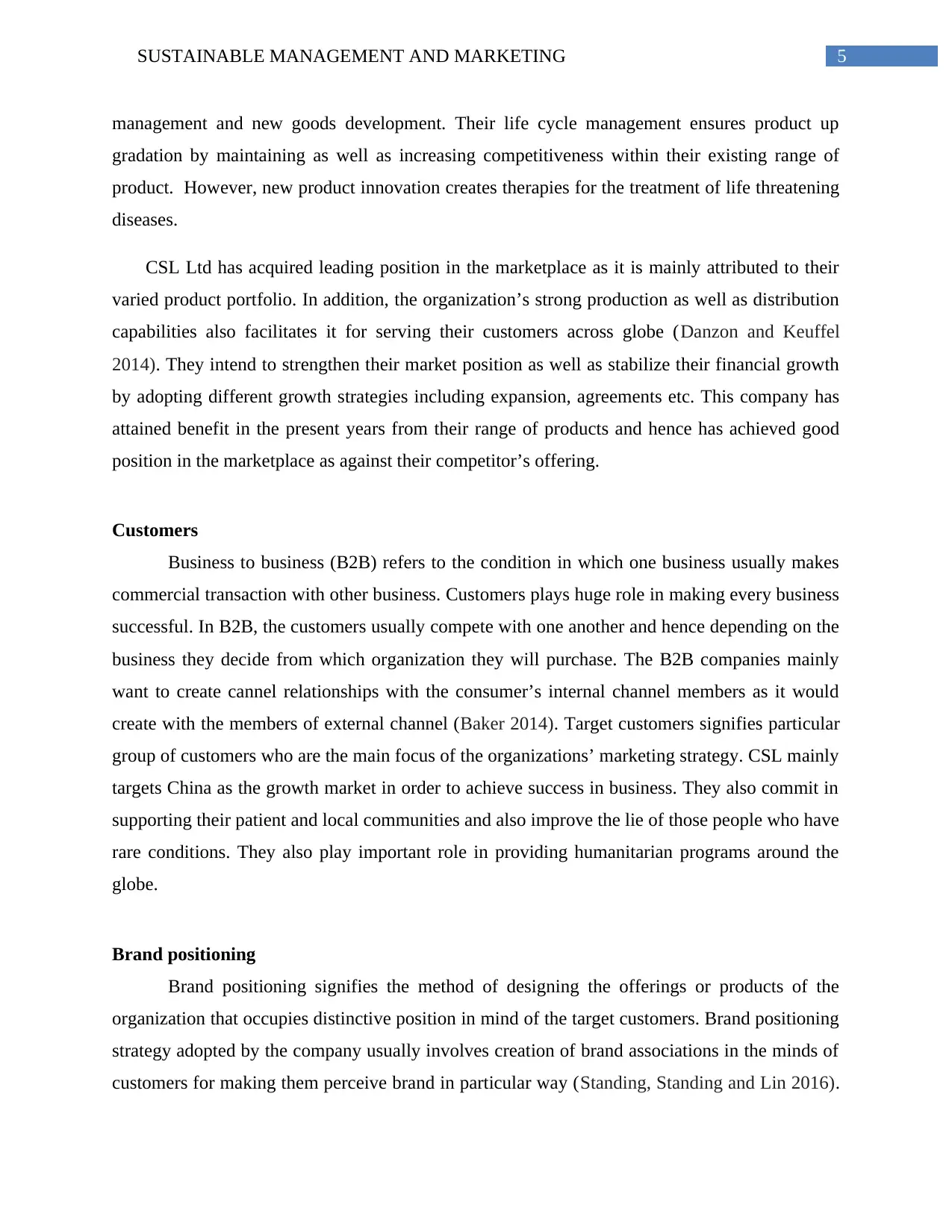
5SUSTAINABLE MANAGEMENT AND MARKETING
management and new goods development. Their life cycle management ensures product up
gradation by maintaining as well as increasing competitiveness within their existing range of
product. However, new product innovation creates therapies for the treatment of life threatening
diseases.
CSL Ltd has acquired leading position in the marketplace as it is mainly attributed to their
varied product portfolio. In addition, the organization’s strong production as well as distribution
capabilities also facilitates it for serving their customers across globe (Danzon and Keuffel
2014). They intend to strengthen their market position as well as stabilize their financial growth
by adopting different growth strategies including expansion, agreements etc. This company has
attained benefit in the present years from their range of products and hence has achieved good
position in the marketplace as against their competitor’s offering.
Customers
Business to business (B2B) refers to the condition in which one business usually makes
commercial transaction with other business. Customers plays huge role in making every business
successful. In B2B, the customers usually compete with one another and hence depending on the
business they decide from which organization they will purchase. The B2B companies mainly
want to create cannel relationships with the consumer’s internal channel members as it would
create with the members of external channel (Baker 2014). Target customers signifies particular
group of customers who are the main focus of the organizations’ marketing strategy. CSL mainly
targets China as the growth market in order to achieve success in business. They also commit in
supporting their patient and local communities and also improve the lie of those people who have
rare conditions. They also play important role in providing humanitarian programs around the
globe.
Brand positioning
Brand positioning signifies the method of designing the offerings or products of the
organization that occupies distinctive position in mind of the target customers. Brand positioning
strategy adopted by the company usually involves creation of brand associations in the minds of
customers for making them perceive brand in particular way (Standing, Standing and Lin 2016).
management and new goods development. Their life cycle management ensures product up
gradation by maintaining as well as increasing competitiveness within their existing range of
product. However, new product innovation creates therapies for the treatment of life threatening
diseases.
CSL Ltd has acquired leading position in the marketplace as it is mainly attributed to their
varied product portfolio. In addition, the organization’s strong production as well as distribution
capabilities also facilitates it for serving their customers across globe (Danzon and Keuffel
2014). They intend to strengthen their market position as well as stabilize their financial growth
by adopting different growth strategies including expansion, agreements etc. This company has
attained benefit in the present years from their range of products and hence has achieved good
position in the marketplace as against their competitor’s offering.
Customers
Business to business (B2B) refers to the condition in which one business usually makes
commercial transaction with other business. Customers plays huge role in making every business
successful. In B2B, the customers usually compete with one another and hence depending on the
business they decide from which organization they will purchase. The B2B companies mainly
want to create cannel relationships with the consumer’s internal channel members as it would
create with the members of external channel (Baker 2014). Target customers signifies particular
group of customers who are the main focus of the organizations’ marketing strategy. CSL mainly
targets China as the growth market in order to achieve success in business. They also commit in
supporting their patient and local communities and also improve the lie of those people who have
rare conditions. They also play important role in providing humanitarian programs around the
globe.
Brand positioning
Brand positioning signifies the method of designing the offerings or products of the
organization that occupies distinctive position in mind of the target customers. Brand positioning
strategy adopted by the company usually involves creation of brand associations in the minds of
customers for making them perceive brand in particular way (Standing, Standing and Lin 2016).
⊘ This is a preview!⊘
Do you want full access?
Subscribe today to unlock all pages.

Trusted by 1+ million students worldwide
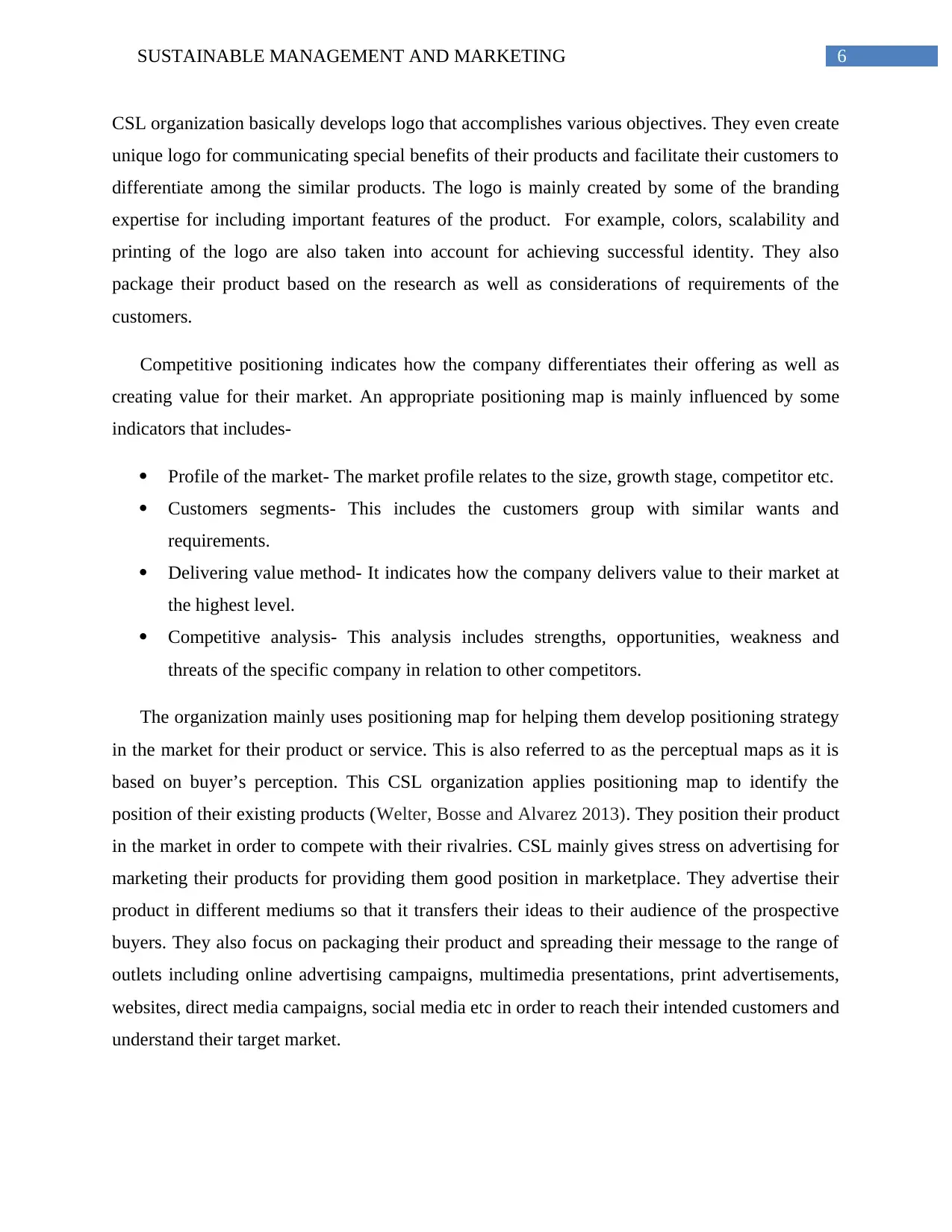
6SUSTAINABLE MANAGEMENT AND MARKETING
CSL organization basically develops logo that accomplishes various objectives. They even create
unique logo for communicating special benefits of their products and facilitate their customers to
differentiate among the similar products. The logo is mainly created by some of the branding
expertise for including important features of the product. For example, colors, scalability and
printing of the logo are also taken into account for achieving successful identity. They also
package their product based on the research as well as considerations of requirements of the
customers.
Competitive positioning indicates how the company differentiates their offering as well as
creating value for their market. An appropriate positioning map is mainly influenced by some
indicators that includes-
Profile of the market- The market profile relates to the size, growth stage, competitor etc.
Customers segments- This includes the customers group with similar wants and
requirements.
Delivering value method- It indicates how the company delivers value to their market at
the highest level.
Competitive analysis- This analysis includes strengths, opportunities, weakness and
threats of the specific company in relation to other competitors.
The organization mainly uses positioning map for helping them develop positioning strategy
in the market for their product or service. This is also referred to as the perceptual maps as it is
based on buyer’s perception. This CSL organization applies positioning map to identify the
position of their existing products (Welter, Bosse and Alvarez 2013). They position their product
in the market in order to compete with their rivalries. CSL mainly gives stress on advertising for
marketing their products for providing them good position in marketplace. They advertise their
product in different mediums so that it transfers their ideas to their audience of the prospective
buyers. They also focus on packaging their product and spreading their message to the range of
outlets including online advertising campaigns, multimedia presentations, print advertisements,
websites, direct media campaigns, social media etc in order to reach their intended customers and
understand their target market.
CSL organization basically develops logo that accomplishes various objectives. They even create
unique logo for communicating special benefits of their products and facilitate their customers to
differentiate among the similar products. The logo is mainly created by some of the branding
expertise for including important features of the product. For example, colors, scalability and
printing of the logo are also taken into account for achieving successful identity. They also
package their product based on the research as well as considerations of requirements of the
customers.
Competitive positioning indicates how the company differentiates their offering as well as
creating value for their market. An appropriate positioning map is mainly influenced by some
indicators that includes-
Profile of the market- The market profile relates to the size, growth stage, competitor etc.
Customers segments- This includes the customers group with similar wants and
requirements.
Delivering value method- It indicates how the company delivers value to their market at
the highest level.
Competitive analysis- This analysis includes strengths, opportunities, weakness and
threats of the specific company in relation to other competitors.
The organization mainly uses positioning map for helping them develop positioning strategy
in the market for their product or service. This is also referred to as the perceptual maps as it is
based on buyer’s perception. This CSL organization applies positioning map to identify the
position of their existing products (Welter, Bosse and Alvarez 2013). They position their product
in the market in order to compete with their rivalries. CSL mainly gives stress on advertising for
marketing their products for providing them good position in marketplace. They advertise their
product in different mediums so that it transfers their ideas to their audience of the prospective
buyers. They also focus on packaging their product and spreading their message to the range of
outlets including online advertising campaigns, multimedia presentations, print advertisements,
websites, direct media campaigns, social media etc in order to reach their intended customers and
understand their target market.
Paraphrase This Document
Need a fresh take? Get an instant paraphrase of this document with our AI Paraphraser
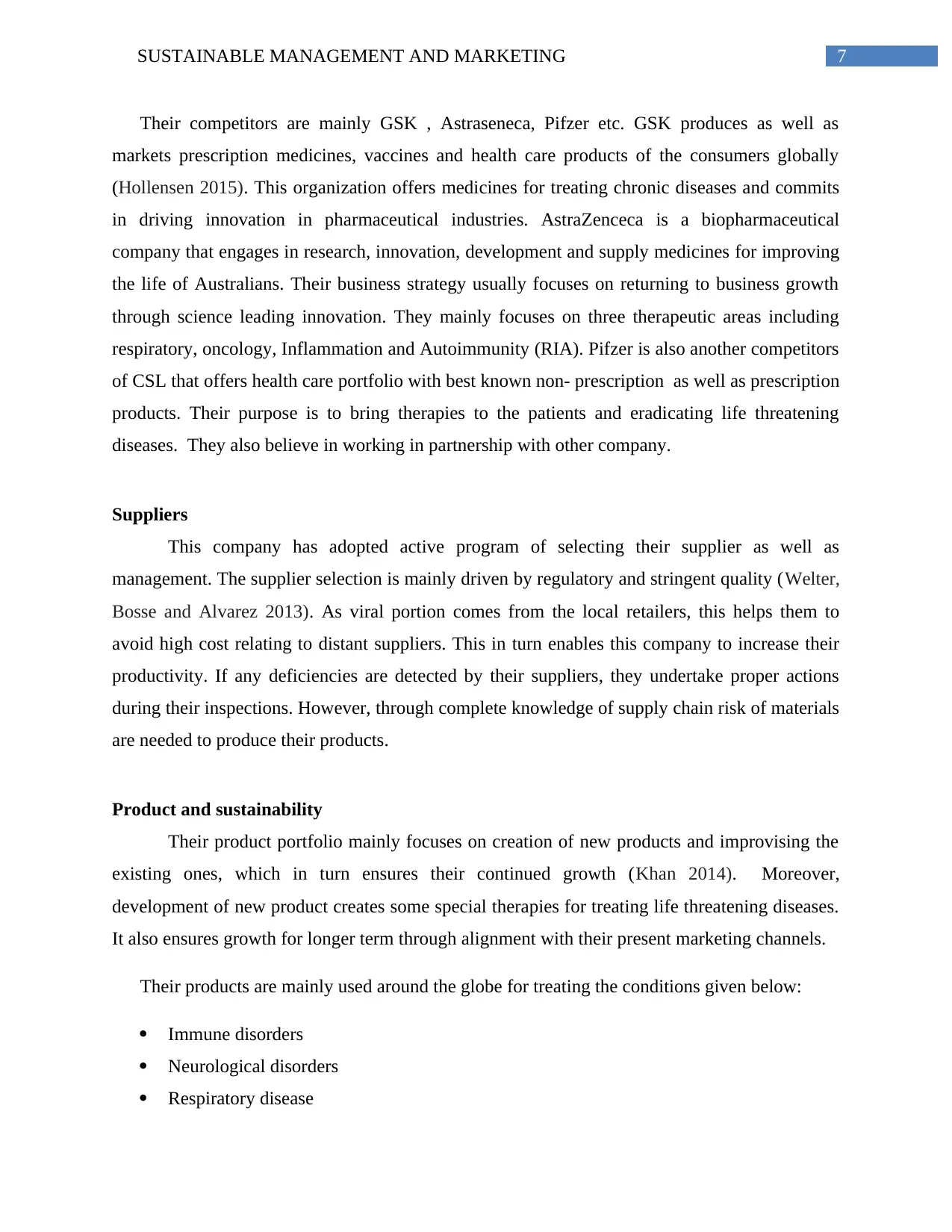
7SUSTAINABLE MANAGEMENT AND MARKETING
Their competitors are mainly GSK , Astraseneca, Pifzer etc. GSK produces as well as
markets prescription medicines, vaccines and health care products of the consumers globally
(Hollensen 2015). This organization offers medicines for treating chronic diseases and commits
in driving innovation in pharmaceutical industries. AstraZenceca is a biopharmaceutical
company that engages in research, innovation, development and supply medicines for improving
the life of Australians. Their business strategy usually focuses on returning to business growth
through science leading innovation. They mainly focuses on three therapeutic areas including
respiratory, oncology, Inflammation and Autoimmunity (RIA). Pifzer is also another competitors
of CSL that offers health care portfolio with best known non- prescription as well as prescription
products. Their purpose is to bring therapies to the patients and eradicating life threatening
diseases. They also believe in working in partnership with other company.
Suppliers
This company has adopted active program of selecting their supplier as well as
management. The supplier selection is mainly driven by regulatory and stringent quality (Welter,
Bosse and Alvarez 2013). As viral portion comes from the local retailers, this helps them to
avoid high cost relating to distant suppliers. This in turn enables this company to increase their
productivity. If any deficiencies are detected by their suppliers, they undertake proper actions
during their inspections. However, through complete knowledge of supply chain risk of materials
are needed to produce their products.
Product and sustainability
Their product portfolio mainly focuses on creation of new products and improvising the
existing ones, which in turn ensures their continued growth (Khan 2014). Moreover,
development of new product creates some special therapies for treating life threatening diseases.
It also ensures growth for longer term through alignment with their present marketing channels.
Their products are mainly used around the globe for treating the conditions given below:
Immune disorders
Neurological disorders
Respiratory disease
Their competitors are mainly GSK , Astraseneca, Pifzer etc. GSK produces as well as
markets prescription medicines, vaccines and health care products of the consumers globally
(Hollensen 2015). This organization offers medicines for treating chronic diseases and commits
in driving innovation in pharmaceutical industries. AstraZenceca is a biopharmaceutical
company that engages in research, innovation, development and supply medicines for improving
the life of Australians. Their business strategy usually focuses on returning to business growth
through science leading innovation. They mainly focuses on three therapeutic areas including
respiratory, oncology, Inflammation and Autoimmunity (RIA). Pifzer is also another competitors
of CSL that offers health care portfolio with best known non- prescription as well as prescription
products. Their purpose is to bring therapies to the patients and eradicating life threatening
diseases. They also believe in working in partnership with other company.
Suppliers
This company has adopted active program of selecting their supplier as well as
management. The supplier selection is mainly driven by regulatory and stringent quality (Welter,
Bosse and Alvarez 2013). As viral portion comes from the local retailers, this helps them to
avoid high cost relating to distant suppliers. This in turn enables this company to increase their
productivity. If any deficiencies are detected by their suppliers, they undertake proper actions
during their inspections. However, through complete knowledge of supply chain risk of materials
are needed to produce their products.
Product and sustainability
Their product portfolio mainly focuses on creation of new products and improvising the
existing ones, which in turn ensures their continued growth (Khan 2014). Moreover,
development of new product creates some special therapies for treating life threatening diseases.
It also ensures growth for longer term through alignment with their present marketing channels.
Their products are mainly used around the globe for treating the conditions given below:
Immune disorders
Neurological disorders
Respiratory disease
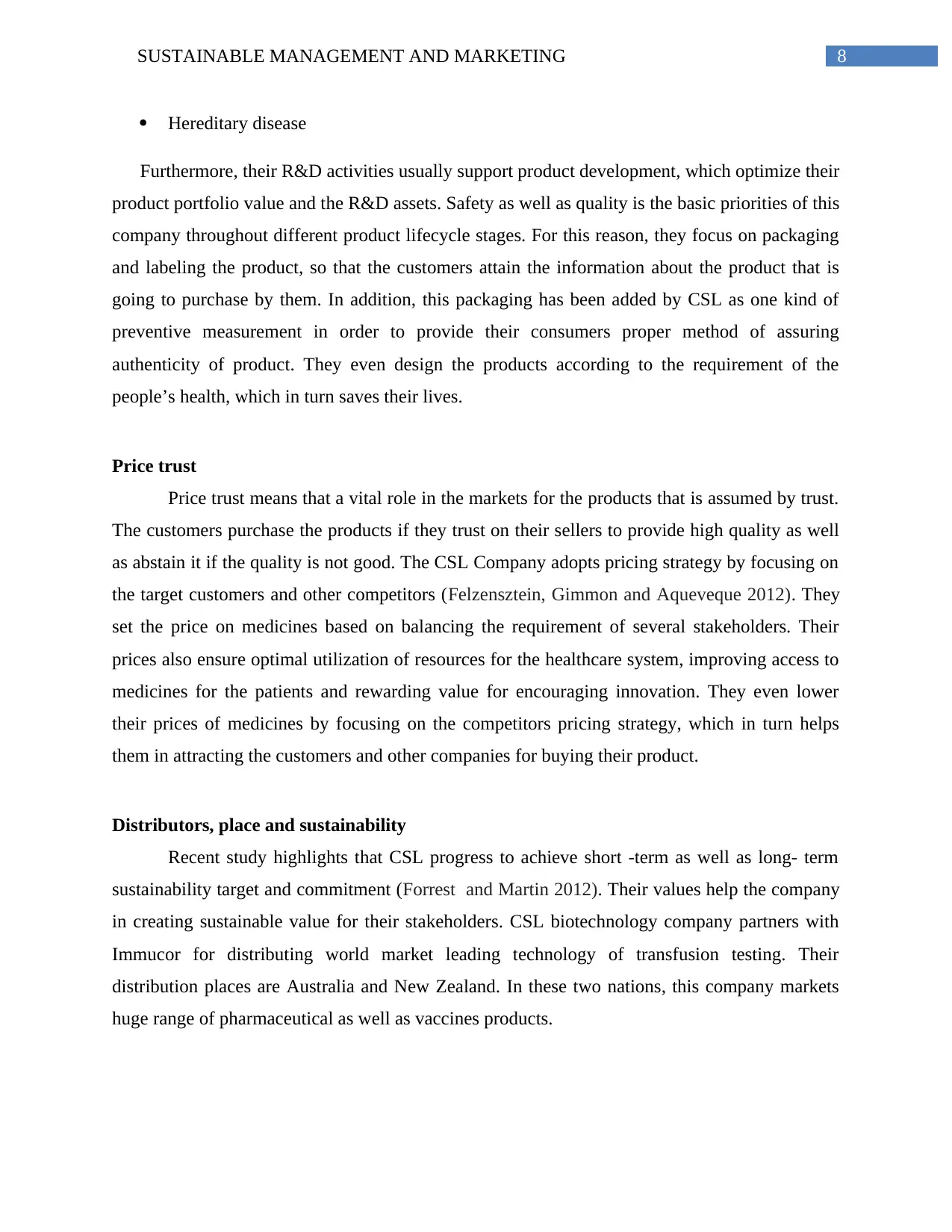
8SUSTAINABLE MANAGEMENT AND MARKETING
Hereditary disease
Furthermore, their R&D activities usually support product development, which optimize their
product portfolio value and the R&D assets. Safety as well as quality is the basic priorities of this
company throughout different product lifecycle stages. For this reason, they focus on packaging
and labeling the product, so that the customers attain the information about the product that is
going to purchase by them. In addition, this packaging has been added by CSL as one kind of
preventive measurement in order to provide their consumers proper method of assuring
authenticity of product. They even design the products according to the requirement of the
people’s health, which in turn saves their lives.
Price trust
Price trust means that a vital role in the markets for the products that is assumed by trust.
The customers purchase the products if they trust on their sellers to provide high quality as well
as abstain it if the quality is not good. The CSL Company adopts pricing strategy by focusing on
the target customers and other competitors (Felzensztein, Gimmon and Aqueveque 2012). They
set the price on medicines based on balancing the requirement of several stakeholders. Their
prices also ensure optimal utilization of resources for the healthcare system, improving access to
medicines for the patients and rewarding value for encouraging innovation. They even lower
their prices of medicines by focusing on the competitors pricing strategy, which in turn helps
them in attracting the customers and other companies for buying their product.
Distributors, place and sustainability
Recent study highlights that CSL progress to achieve short -term as well as long- term
sustainability target and commitment (Forrest and Martin 2012). Their values help the company
in creating sustainable value for their stakeholders. CSL biotechnology company partners with
Immucor for distributing world market leading technology of transfusion testing. Their
distribution places are Australia and New Zealand. In these two nations, this company markets
huge range of pharmaceutical as well as vaccines products.
Hereditary disease
Furthermore, their R&D activities usually support product development, which optimize their
product portfolio value and the R&D assets. Safety as well as quality is the basic priorities of this
company throughout different product lifecycle stages. For this reason, they focus on packaging
and labeling the product, so that the customers attain the information about the product that is
going to purchase by them. In addition, this packaging has been added by CSL as one kind of
preventive measurement in order to provide their consumers proper method of assuring
authenticity of product. They even design the products according to the requirement of the
people’s health, which in turn saves their lives.
Price trust
Price trust means that a vital role in the markets for the products that is assumed by trust.
The customers purchase the products if they trust on their sellers to provide high quality as well
as abstain it if the quality is not good. The CSL Company adopts pricing strategy by focusing on
the target customers and other competitors (Felzensztein, Gimmon and Aqueveque 2012). They
set the price on medicines based on balancing the requirement of several stakeholders. Their
prices also ensure optimal utilization of resources for the healthcare system, improving access to
medicines for the patients and rewarding value for encouraging innovation. They even lower
their prices of medicines by focusing on the competitors pricing strategy, which in turn helps
them in attracting the customers and other companies for buying their product.
Distributors, place and sustainability
Recent study highlights that CSL progress to achieve short -term as well as long- term
sustainability target and commitment (Forrest and Martin 2012). Their values help the company
in creating sustainable value for their stakeholders. CSL biotechnology company partners with
Immucor for distributing world market leading technology of transfusion testing. Their
distribution places are Australia and New Zealand. In these two nations, this company markets
huge range of pharmaceutical as well as vaccines products.
⊘ This is a preview!⊘
Do you want full access?
Subscribe today to unlock all pages.

Trusted by 1+ million students worldwide
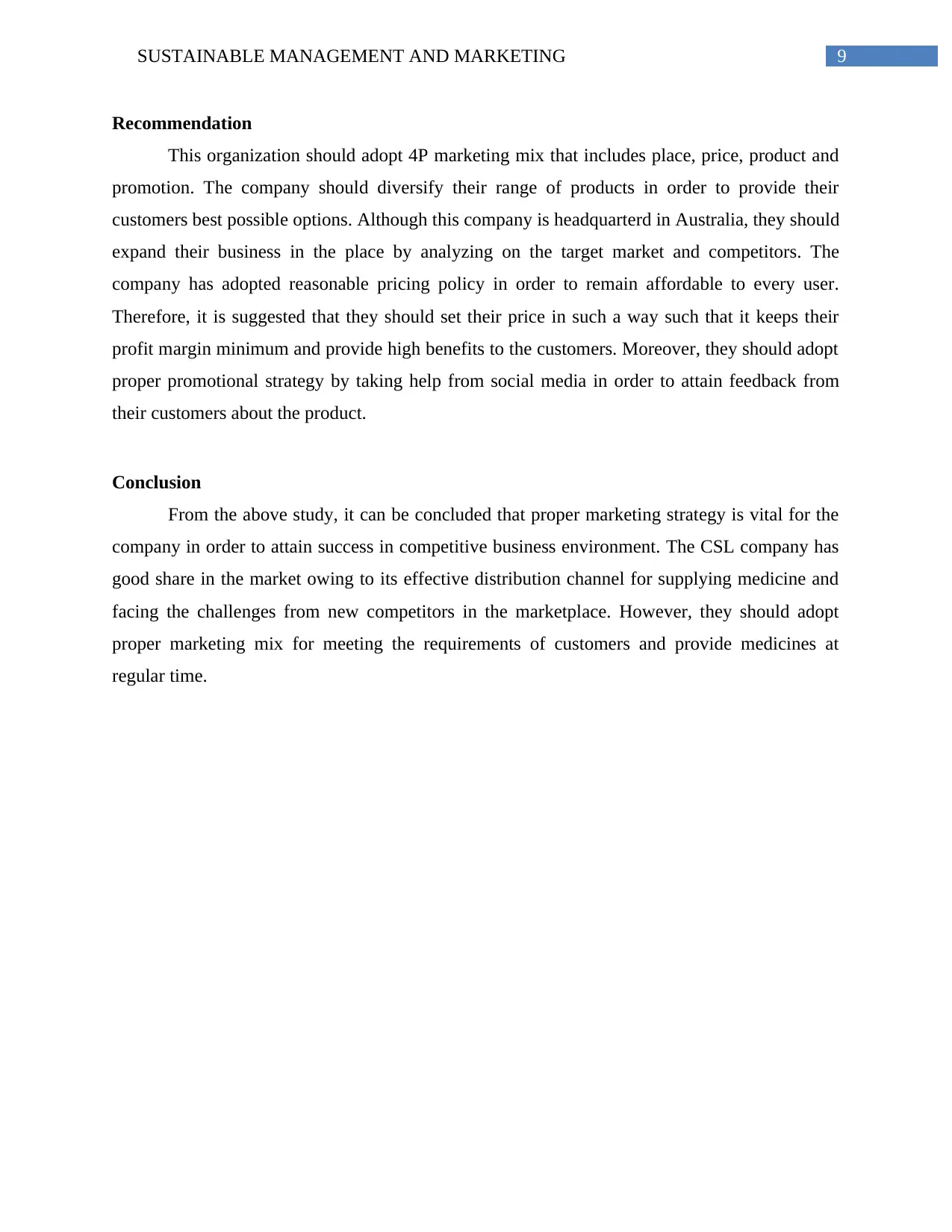
9SUSTAINABLE MANAGEMENT AND MARKETING
Recommendation
This organization should adopt 4P marketing mix that includes place, price, product and
promotion. The company should diversify their range of products in order to provide their
customers best possible options. Although this company is headquarterd in Australia, they should
expand their business in the place by analyzing on the target market and competitors. The
company has adopted reasonable pricing policy in order to remain affordable to every user.
Therefore, it is suggested that they should set their price in such a way such that it keeps their
profit margin minimum and provide high benefits to the customers. Moreover, they should adopt
proper promotional strategy by taking help from social media in order to attain feedback from
their customers about the product.
Conclusion
From the above study, it can be concluded that proper marketing strategy is vital for the
company in order to attain success in competitive business environment. The CSL company has
good share in the market owing to its effective distribution channel for supplying medicine and
facing the challenges from new competitors in the marketplace. However, they should adopt
proper marketing mix for meeting the requirements of customers and provide medicines at
regular time.
Recommendation
This organization should adopt 4P marketing mix that includes place, price, product and
promotion. The company should diversify their range of products in order to provide their
customers best possible options. Although this company is headquarterd in Australia, they should
expand their business in the place by analyzing on the target market and competitors. The
company has adopted reasonable pricing policy in order to remain affordable to every user.
Therefore, it is suggested that they should set their price in such a way such that it keeps their
profit margin minimum and provide high benefits to the customers. Moreover, they should adopt
proper promotional strategy by taking help from social media in order to attain feedback from
their customers about the product.
Conclusion
From the above study, it can be concluded that proper marketing strategy is vital for the
company in order to attain success in competitive business environment. The CSL company has
good share in the market owing to its effective distribution channel for supplying medicine and
facing the challenges from new competitors in the marketplace. However, they should adopt
proper marketing mix for meeting the requirements of customers and provide medicines at
regular time.
Paraphrase This Document
Need a fresh take? Get an instant paraphrase of this document with our AI Paraphraser
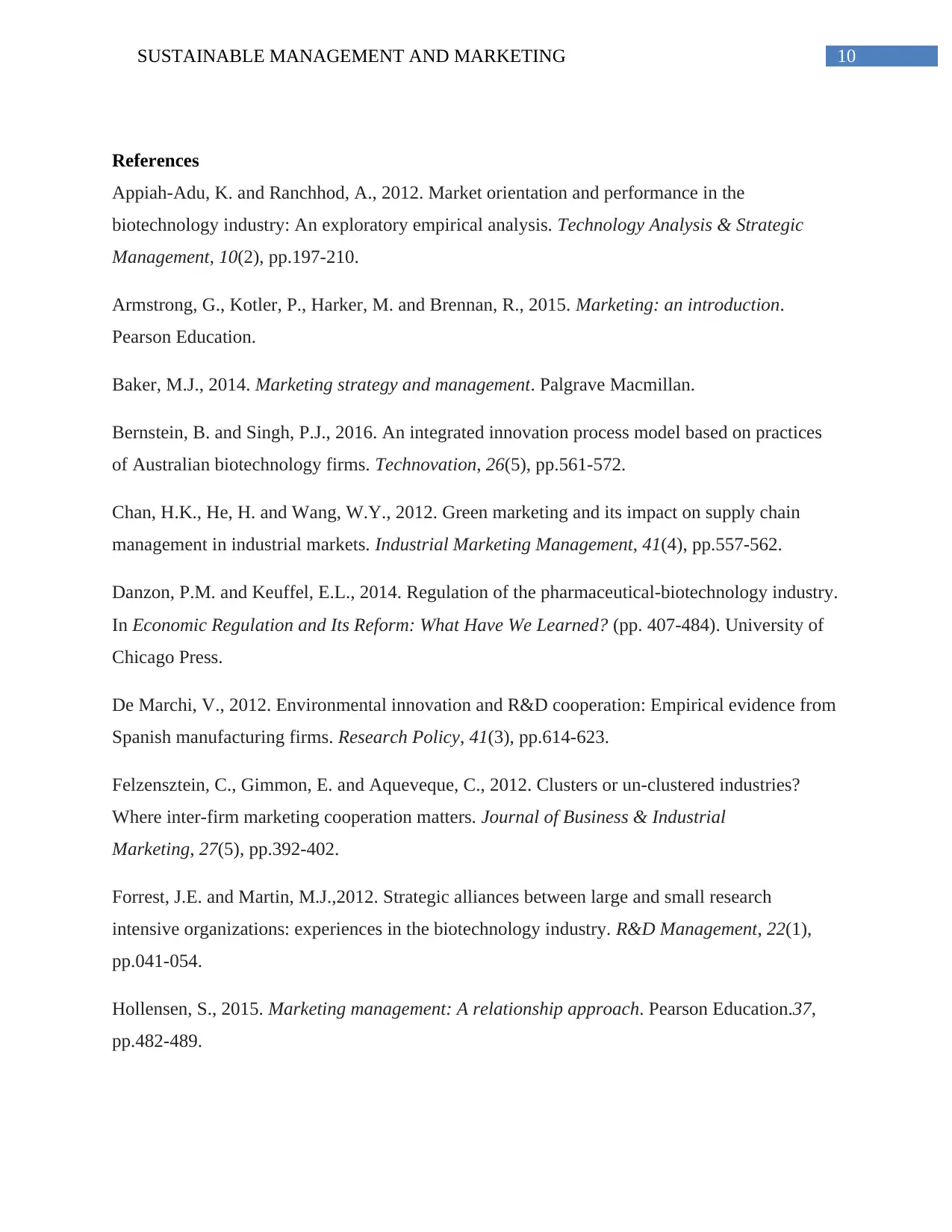
10SUSTAINABLE MANAGEMENT AND MARKETING
References
Appiah-Adu, K. and Ranchhod, A., 2012. Market orientation and performance in the
biotechnology industry: An exploratory empirical analysis. Technology Analysis & Strategic
Management, 10(2), pp.197-210.
Armstrong, G., Kotler, P., Harker, M. and Brennan, R., 2015. Marketing: an introduction.
Pearson Education.
Baker, M.J., 2014. Marketing strategy and management. Palgrave Macmillan.
Bernstein, B. and Singh, P.J., 2016. An integrated innovation process model based on practices
of Australian biotechnology firms. Technovation, 26(5), pp.561-572.
Chan, H.K., He, H. and Wang, W.Y., 2012. Green marketing and its impact on supply chain
management in industrial markets. Industrial Marketing Management, 41(4), pp.557-562.
Danzon, P.M. and Keuffel, E.L., 2014. Regulation of the pharmaceutical-biotechnology industry.
In Economic Regulation and Its Reform: What Have We Learned? (pp. 407-484). University of
Chicago Press.
De Marchi, V., 2012. Environmental innovation and R&D cooperation: Empirical evidence from
Spanish manufacturing firms. Research Policy, 41(3), pp.614-623.
Felzensztein, C., Gimmon, E. and Aqueveque, C., 2012. Clusters or un-clustered industries?
Where inter-firm marketing cooperation matters. Journal of Business & Industrial
Marketing, 27(5), pp.392-402.
Forrest, J.E. and Martin, M.J.,2012. Strategic alliances between large and small research
intensive organizations: experiences in the biotechnology industry. R&D Management, 22(1),
pp.041-054.
Hollensen, S., 2015. Marketing management: A relationship approach. Pearson Education.37,
pp.482-489.
References
Appiah-Adu, K. and Ranchhod, A., 2012. Market orientation and performance in the
biotechnology industry: An exploratory empirical analysis. Technology Analysis & Strategic
Management, 10(2), pp.197-210.
Armstrong, G., Kotler, P., Harker, M. and Brennan, R., 2015. Marketing: an introduction.
Pearson Education.
Baker, M.J., 2014. Marketing strategy and management. Palgrave Macmillan.
Bernstein, B. and Singh, P.J., 2016. An integrated innovation process model based on practices
of Australian biotechnology firms. Technovation, 26(5), pp.561-572.
Chan, H.K., He, H. and Wang, W.Y., 2012. Green marketing and its impact on supply chain
management in industrial markets. Industrial Marketing Management, 41(4), pp.557-562.
Danzon, P.M. and Keuffel, E.L., 2014. Regulation of the pharmaceutical-biotechnology industry.
In Economic Regulation and Its Reform: What Have We Learned? (pp. 407-484). University of
Chicago Press.
De Marchi, V., 2012. Environmental innovation and R&D cooperation: Empirical evidence from
Spanish manufacturing firms. Research Policy, 41(3), pp.614-623.
Felzensztein, C., Gimmon, E. and Aqueveque, C., 2012. Clusters or un-clustered industries?
Where inter-firm marketing cooperation matters. Journal of Business & Industrial
Marketing, 27(5), pp.392-402.
Forrest, J.E. and Martin, M.J.,2012. Strategic alliances between large and small research
intensive organizations: experiences in the biotechnology industry. R&D Management, 22(1),
pp.041-054.
Hollensen, S., 2015. Marketing management: A relationship approach. Pearson Education.37,
pp.482-489.
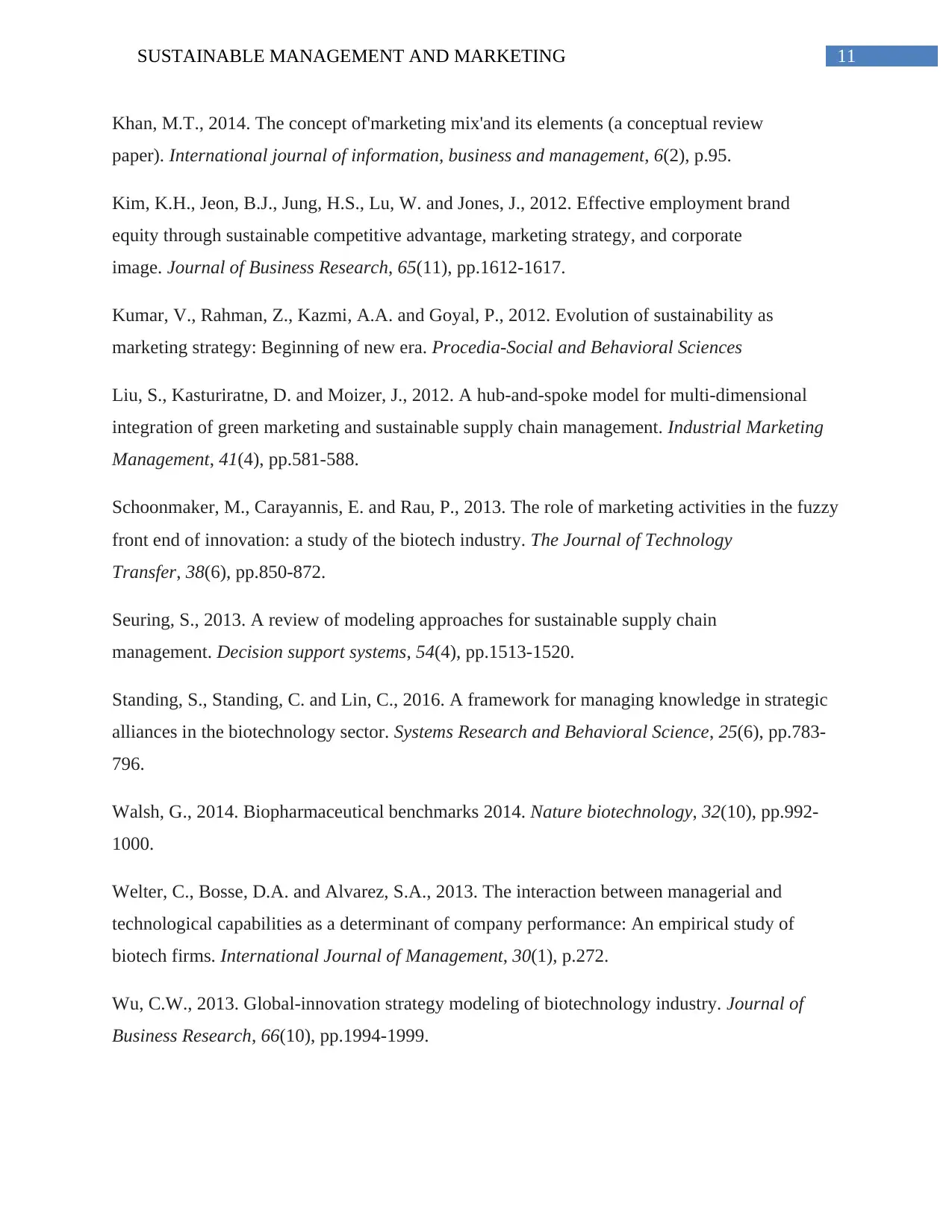
11SUSTAINABLE MANAGEMENT AND MARKETING
Khan, M.T., 2014. The concept of'marketing mix'and its elements (a conceptual review
paper). International journal of information, business and management, 6(2), p.95.
Kim, K.H., Jeon, B.J., Jung, H.S., Lu, W. and Jones, J., 2012. Effective employment brand
equity through sustainable competitive advantage, marketing strategy, and corporate
image. Journal of Business Research, 65(11), pp.1612-1617.
Kumar, V., Rahman, Z., Kazmi, A.A. and Goyal, P., 2012. Evolution of sustainability as
marketing strategy: Beginning of new era. Procedia-Social and Behavioral Sciences
Liu, S., Kasturiratne, D. and Moizer, J., 2012. A hub-and-spoke model for multi-dimensional
integration of green marketing and sustainable supply chain management. Industrial Marketing
Management, 41(4), pp.581-588.
Schoonmaker, M., Carayannis, E. and Rau, P., 2013. The role of marketing activities in the fuzzy
front end of innovation: a study of the biotech industry. The Journal of Technology
Transfer, 38(6), pp.850-872.
Seuring, S., 2013. A review of modeling approaches for sustainable supply chain
management. Decision support systems, 54(4), pp.1513-1520.
Standing, S., Standing, C. and Lin, C., 2016. A framework for managing knowledge in strategic
alliances in the biotechnology sector. Systems Research and Behavioral Science, 25(6), pp.783-
796.
Walsh, G., 2014. Biopharmaceutical benchmarks 2014. Nature biotechnology, 32(10), pp.992-
1000.
Welter, C., Bosse, D.A. and Alvarez, S.A., 2013. The interaction between managerial and
technological capabilities as a determinant of company performance: An empirical study of
biotech firms. International Journal of Management, 30(1), p.272.
Wu, C.W., 2013. Global-innovation strategy modeling of biotechnology industry. Journal of
Business Research, 66(10), pp.1994-1999.
Khan, M.T., 2014. The concept of'marketing mix'and its elements (a conceptual review
paper). International journal of information, business and management, 6(2), p.95.
Kim, K.H., Jeon, B.J., Jung, H.S., Lu, W. and Jones, J., 2012. Effective employment brand
equity through sustainable competitive advantage, marketing strategy, and corporate
image. Journal of Business Research, 65(11), pp.1612-1617.
Kumar, V., Rahman, Z., Kazmi, A.A. and Goyal, P., 2012. Evolution of sustainability as
marketing strategy: Beginning of new era. Procedia-Social and Behavioral Sciences
Liu, S., Kasturiratne, D. and Moizer, J., 2012. A hub-and-spoke model for multi-dimensional
integration of green marketing and sustainable supply chain management. Industrial Marketing
Management, 41(4), pp.581-588.
Schoonmaker, M., Carayannis, E. and Rau, P., 2013. The role of marketing activities in the fuzzy
front end of innovation: a study of the biotech industry. The Journal of Technology
Transfer, 38(6), pp.850-872.
Seuring, S., 2013. A review of modeling approaches for sustainable supply chain
management. Decision support systems, 54(4), pp.1513-1520.
Standing, S., Standing, C. and Lin, C., 2016. A framework for managing knowledge in strategic
alliances in the biotechnology sector. Systems Research and Behavioral Science, 25(6), pp.783-
796.
Walsh, G., 2014. Biopharmaceutical benchmarks 2014. Nature biotechnology, 32(10), pp.992-
1000.
Welter, C., Bosse, D.A. and Alvarez, S.A., 2013. The interaction between managerial and
technological capabilities as a determinant of company performance: An empirical study of
biotech firms. International Journal of Management, 30(1), p.272.
Wu, C.W., 2013. Global-innovation strategy modeling of biotechnology industry. Journal of
Business Research, 66(10), pp.1994-1999.
⊘ This is a preview!⊘
Do you want full access?
Subscribe today to unlock all pages.

Trusted by 1+ million students worldwide
1 out of 12
Related Documents
Your All-in-One AI-Powered Toolkit for Academic Success.
+13062052269
info@desklib.com
Available 24*7 on WhatsApp / Email
![[object Object]](/_next/static/media/star-bottom.7253800d.svg)
Unlock your academic potential
Copyright © 2020–2025 A2Z Services. All Rights Reserved. Developed and managed by ZUCOL.





